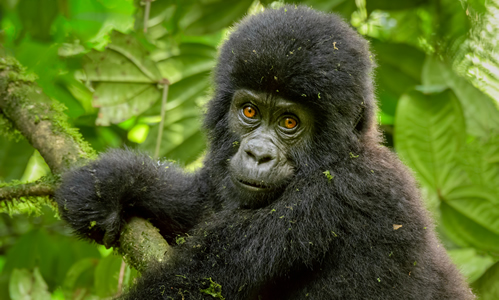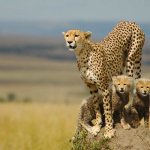10 Top facts about Gorillas
10 Top facts about Gorillas :Gorillas are classified as endangered primates with hairy bodies, hands, and legs similar to humans, and the whole remaining population lives in Africa. The information in this article includes a number of gorilla facts.
Species of Gorillas.
The species of gorillas is one of the top ten facts about gorillas. There are two different species of gorillas: western and eastern gorillas. The Eastern lowland gorillas and the mountain gorillas are two subspecies that belong to the Eastern gorillas.
Gorillas, such as mountain gorillas, prefer high altitude habitats, which explains why they are found in the East Africa region in places like Bwindi Impenetrable National Park, Mgahinga Gorilla National Park, Volcanoes National Park in Rwanda, and Virunga National Park in the Democratic Republic of the Congo (DRC).
Democratic Republic of the Congo (DRC) is the greatest place in East Africa to go for gorilla trekking safari because it is home to both mountain gorillas in Virunga National Park and eastern lowland gorillas in Kahuzi Beiga National Park.
10 Top facts about Gorillas : Gorillas share their DNA with humans.
Gorillas are the largest species of great apes, and they have 98% of the human genome in common with us. This suggests that gorillas act like people; they are observed laughing, mating, breastfeeding, and many other behaviors. However, they lack human speech, even if they have their own sound and a few gestures they employ to communicate with one another. Gorillas frequently be heard hooting, thumping their chests, and making other loud noises.
The diet of all gorillas is the same, and they are primarily herbivorous.
Even though gorillas vary greatly in weight, they generally eat around the same quantity of food each day. They particularly like eating various plant species, bamboo shoots, leaves, and occasionally small animals that they capture when hunting in the jungle. They become curious as a result, meandering around the entire forest and even scaling hills and mountains, especially the eastern gorillas, who are looking for food. This suggests that gorillas spend the entire day eating and sleeping.
10 Top facts about Gorillas : Gorillas sleep in Nests.
Gorillas build comfortable nests high in the tree branches at night to rest after a long day of feeding. This is constructed from other tree branches and foliage, and the fact that the nest has only been used once suggests that gorillas build new nests each evening to spend the night in. Though most often they all sleep up in the tree branches, some gorillas, particularly the silverback gorillas, build their nests on the ground.
10 Top facts about Gorillas : Gorillas are strong primates and intelligent.

10 Top facts about Gorillas
Strong and large primates include gorillas. For example, while a female normal gorilla weighs about 135kg, male mountain gorillas weigh 180kg and are roughly 170 cm long. Since a silverback gorilla is known as the head of the family and is therefore responsible for protecting the entire family against damage, he can fight anything, including humans, to save his family members. Gorillas, on the other hand, are the calmest and most tranquil primates if they are not disturbed, but if they become violent, they can battle an enemy to the death.
10 Top facts about Gorillas : Male adult gorillas are called silverbacks.
The silverback gorilla is a male adult gorilla. The name of this came from the silvery hair that may be seen on the backs of all mature male gorillas. As a result, when a male gorilla reaches sexual maturity and has silver or grey hair on his back, he is given the name silverback, and the young are referred to as blackbucks.
10 Top facts about Gorillas : Gorillas live in groups/ families led by a dominant silverback.
Although some gorilla groups are led by two dominant silverbacks, in most cases, the silverbacks are seen fighting occasionally until the group splits and each silverback stays with his own family. Gorillas live in families or groups, with one dominant silverback serving as the head of the family. In order to expand their family, the silverbacks fight other silverbacks and kidnap the females from other families. There is always conflict when there are multiple mature silverbacks in a group because they are all competing to mate with the same females. The stronger silverback eventually drives the weaker one out of the group and makes him a loner silverback until he is able to gather females and start his own family.
10 Top facts about Gorillas : Female gorillas are considered mature at an age of 10
A female gorilla is thought to be grown and reproductive when she is 10 years old, at which point she can begin reproducing. Because gorillas and humans share DNA, female gorillas can also become pregnant and carry the baby for nine months over an interval of four to five years.
10 Top facts about Gorillas : Male gorillas are considered to be mature at the age of 15
Male gorillas reach maturity at the age of 15, whilst female gorillas do so at 10. A male gorilla is grown enough to begin mating with females at this age.
10 Top facts about Gorillas : Gorillas are endangered primate species.
Since there are still over 100,000 species of western gorillas living in the wild, gorillas are considered an endangered species of primates. With at least 1063 species of mountain gorillas still existing in the wild, the eastern gorillas, particularly the mountain gorillas, are considered to be more endangered primates. The human component is the main cause of the endangered mountain gorillas’ population reduction. Mountain gorilla populations were drastically decreased by human encroachment on their habitats as people cleared land for farming and hunting, to the point that they are now severely endangered. However, as gorilla populations began to increase over time, land encroachers were forcibly removed from the animals’ habitats. This was done in a number of ways, including educating the local communities that live close to the parks about the benefits of gorillas, particularly for the tourism sector.
Conservation status.
As a result of conservation actions implemented by relevant wildlife organizations, the status of gorillas has recently changed from critically endangered to and recently its endangered with the prospect of an increase in the population in the near future.







Leave a Reply
Want to join the discussion?Feel free to contribute!